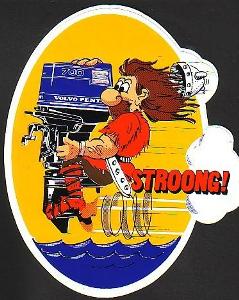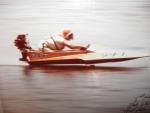Hi all!
I need help to decide what to do with the running surface on my tunnel hull.
In Sweden we have a racing class called "Classic offshore". The boat model must be at least 25 years old, you choose your own pace an try to come as close to it as possible and then the contestants vote about which boat is most authentic. This boat is restored for this class.
Here is the background:
the boat is 4.65m long and 2.05 wide, the tunnel is 1.2 wide, weight without crew (two persons) is ~325kg Speed is so far 46knots with a OMC 3-cyl 56ci 70hp but comparable boats run at least 50-60knots.
From the beginning there were no cutout in the aft portion of the "pontoon" and the lifting strake was the same size from bow to stern. A previous owner have made a step / cutout and reduced the size of the lifting strake the last meter of the running surface.
The running surface also have a very small transverse step some .3m from the cutout. This however is very small and I doubt that it can get any air from the sides. the shape of the step is also strange (to me at least) since the surface before and after the step lies in the same plane, the step it self is actually only a wedge and a cavity other than that the bottom is straight. The wedge is only about 5mm high but it appears to me that this would act as if the bottom had a severe hook pulling the bow down.
From what I have been told this boat model (make and size) is a poor performer in tail wind but works well with a little head wind. I have not driven any other boat of this type before so I don't have anything to compare to but I know that it is faster running into the wind, not to mention the ride is a lot smoother...
It is very hard to get on plane with full fuel tanks and my navigator have to climb past me up on the deck, this is not really allowed by the rules (as far as I recall). Once on plane the boat feels like it would need to have the weight even further back. not an ideal situation since there is nothing to move besides me and that would take some serious modification.
It would not be to hard to grind down the wedge and fill the remains of the step creating a straight running surface BUT There must be some reasons that the step is there in the first place. I've seen a lot of different ways to build the running surface on a cat but I have never seen this configuration before and maybe they just got it wrong.
Do you think the running surface look good as is or should I alter it? If it were your boat what would you try?
Please share your thoughts and ideas!
Video of the boat:
This is from when I was breaking in an old (rebuilt) engine so the speed is not very high but gives you a good idea what the boat looks like though.
Pictures of the running surfaces: https://plus.google.com/photos/11139...NOatISW9_7sngE
Just for fun!
Navigators view:
http://www.youtube.com/watch?v=FJnJ_XKzcms
Our Classic Offshore site: http://www.classicoffshore.se/
English is not my native language so please ask if something doesn't make sense to you!


 Thanks:
Thanks:  Likes:
Likes: 



 Reply With Quote
Reply With Quote

 I was told that when the hull was built it only weighed 75kg, that was before any of the reinforcement was added (transom, knees, stringers and such) but it was built around -83 so I guess no one really remembers...
I was told that when the hull was built it only weighed 75kg, that was before any of the reinforcement was added (transom, knees, stringers and such) but it was built around -83 so I guess no one really remembers...
Bookmarks